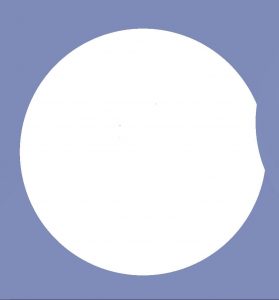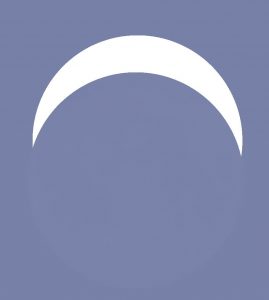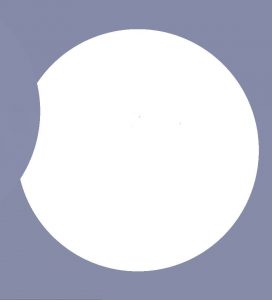August 21 is the date that amateur astronomers have been looking forward to for years because it is the date of the first total solar eclipse to occur in the continental United States in more than 38 years. This month we’ll talk about what to expect.
There will be two kinds of people in the USA on August 21st: Those who will be the central path of the eclipse, an approximately 70-mile-wide band that stretches from the Pacific coast of Oregon to the Atlantic coast of South Carolina, and those that won’t. All of them will have the opportunity to see some aspect of the eclipse however, weather permitting.
The entire country will be the moon’s penumbral shadow cast by the sun. When you look up at the sun from within this shadow, you will notice that the sun seems to look like a cookie with a bite out of it. This is because the moon, as it orbits the earth, is occulting, i.e. blocking, the sun. The size of the bite depends where in the shadow the observer is. The deeper inside it you are, the larger the apparent bite will get.
In Carroll County on that Monday afternoon, the partial eclipse starts at 01:17:20 p.m. Several minutes later observers equipped to safely observe will notice a little notch on the right side of the sun. Over the next hour the moon will cover more and more of the sun, maxing out at 02:45:51 p.m. with 79% obscuration. It will still be daylight outside and proper filters are needed to directly see any of it.
|
|
|
|
| Eclipse graphics for Westminster by Curtis Roelle using Stellarium planetarium software. | ||
An eclipse occurs in four events or contacts, numbered 1 through 4. The starting and ending points as observed from Carroll County are 1st and 4th contacts, respectively. So what happened about 2nd and 3rd contact? The only way to experience those is in the narrow zone of totality, mentioned earlier.
As observed from the central path of the eclipse, the visible crescent of the sun continues to shrink in width growing ever narrower. The sky begins to noticeably darken as the moon’s umbral shadow approaches from the west. Looking skyward, the brighter planets become visible – Venus, then Jupiter, followed by Mars and Mercury.
The temperature has noticeably dropped and cool breezes spring up from apparently nowhere. In the final minutes the sky darkens as though a thunderstorm is quickly moving in. Except it is perfectly clear and stars are starting to shine.
The sun is only a thin crescent and the tips of the horns are shrinking and approaching one another. As they recede to a point the sun gives one last flash. This is the so-called “diamond ring” effect. The sun is completely blotted out by the dark moon, but is surrounded by light from the solar corona, the sun’s outer atmospheric layers.
The eclipse glasses and telescope filters all come off. The sun is completely blocked and it is now safe to view without protection for the next couple of minutes or so, depending on where you are.
As soon as the sun’s bright photosphere layer is covered, the pinkish-red chromosphere is visible along the edge of the moon and then it too is eclipsed. Pink prominences are seen here and there around the edge of the eclipsed sun, appearing like frozen flames. Their color comes from the hydrogen gas they are made of.
Although the sky is a deep blue, the horizon all the way around has the color of twilight. It’s not limited to only the east or west as in the morning or evening, but it completely encircles you.
As your eyes become more accustomed to the dark, the solar corona can be seen for several solar radii surrounding the blackened orb of the moon.
All too soon a brilliant spot of light erupts on the opposite edge of the moon from where it began. Totality ends as the sky lightens. Although the eclipse is over, the corona may still be visible for another half minute. Totality has ended and it is time to return the solar filters to their working positions for safety.
The beginning of totality is 2nd contact and its ending is 3rd contact. These two events will only be witnessed by people who are observing the eclipse from the central path.
In Maryland, the entire eclipse will be a partial solar eclipse. There is no total solar eclipse in Maryland in 2017. For this reason, safe viewing techniques must be used throughout the event. One of the most popular items are the so-called “eclipse glasses” made with optical black polymer or Mylar with a protective metallic coating.
The Westminster Astronomical Society still has a supply of these specialized glasses and have been endeavoring all summer to distribute them to the public. They can be picked up at WASI events between now and eclipse time. See a list of their upcoming events on their web site at WestminsterAstro.org and click on the “Events” tab. Several upcoming events include the following:
- Thu Aug 10: 8-10 p.m. at “Little Roundtop” at the Getysburg National Military Park, in Gettysburg
- Sat Aug 12: 7-10:30 p.m. Planetarium program and star party at Bear Branch Nature Center, Westminster
- Sat Aug 12: 8-10 p.m.: Soldiers Delight Natural Environmental Center, Owings Mills



